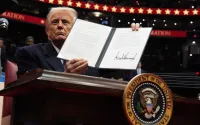 Debate will continue on whether the Kyoto glass is half full or half empty |
It gives no term though for the person who, having been in despair at believing his or her glass drained, rises with joyous heart on finding it yet holds a few welcome splashes.
This is unfortunate; for in analysing the fallout from the two weeks of climate talks in Montreal, it might just be the key word.
Environmental campaigners and Kyoto-minded governments went to Canada believing they might see the Kyoto model consigned to oblivion, its ashes ceremonially scattered on the St Lawrence river and floated off to the still frozen Arctic.
That has not happened. The model of mandatory fixed targets and timetables for reducing greenhouse gas emissions is still alive.
That is what enabled Tony Blair to describe the final agreement as "a vital next step in tackling climate change", and his Environment Secretary Margaret Beckett to hail a "diplomatic triumph".
It is why Guy Thompson of the Green Alliance could conclude "this... keeps Kyoto alive and builds momentum towards a legally binding global framework beyond 2012", why Greenpeace International's Bill Hare could declare "the Kyoto Protocol is stronger today than it was two weeks ago", and why Tony Juniper from Friends of the Earth could opine: "This meeting has made a historic agreement which will strengthen global resolve."
Champagne all round, then. But stay - what is that shadow falling on the other side of the drinks trolley?
Split personality
The "Annex 1" parties still inside the Kyoto process - in other words, developed nations plus former Soviet bloc states minus the US and Australia - pledged to "initiate a process to consider further commitments for parties included in Annex 1 (i.e. themselves) for the period beyond 2012".
They vowed to begin directly, and to finish negotiations soon enough that there is a smooth transition between the date when existing targets expire (2012) and the beginning of this projected second period of commitments.
 For Europe, there is a commitment to further binding targets |
So far, so good. But Kyoto Annex 1 countries account only for about one-third of global greenhouse gas emissions. So what commitments has Montreal wrung from the remainder?
Essentially, a commitment to further talks, an "open and non-binding exchange of views, information and ideas" which "will not open any negotiations leading to new commitments".
These talks will focus on advancing development goals, helping countries adapt to the impact of climate change, and "realising the potential" of technology and market-based opportunities.
Two sets of words, then, in what had always been a conference with a split personality.
Europe and Japan win a commitment to further binding targets for those who already have them, while for Kyoto-sceptics and the developing world, the prize is a generalised dialogue which specifically excludes concrete targets.
Plot lines
It is always tempting at these meetings to focus on the drama - the American walkout and the off-the-cuff speech of former US President Bill Clinton, the innate rhythm which drives negotiations deep into the night and ends with sudden resolution, like the dark minor chords of Mozart melancholy resolving into a sunlit finale.
But these UN gatherings are in reality brief busy punctuation marks in an on-going narrative.
 Anti-US sentiment was evident in protests |
As near as one can pin it down, the scientific consensus is that in order to avoid dangerous climate change, concentrations ought to peak around 2020 to 2030, and decline thereafter.
Forget the final day emoting, then, and look at the Montreal agreement in this light.
Yes, valuable progress was made on Kyoto Protocol mechanisms, agreeing the rules by which it will operate and developing programmes through which richer countries can contribute to emissions reduction in poorer nations.
Yes, the Annex 1 parties will talk about further targets and timetables.
But in reality many of them have veered spectacularly off the course required to meet their existing targets, never mind future ones.
The US, responsible for between one-quarter and one-fifth of global emissions, declines to sup in the same bar.
Crucially, there is little sign that countries like India and China, with their fast-growing economies and fast-rising greenhouse gas emissions, are clamouring to join the post-Kyoto party.
As Indian Environment Minister Andimuthu Raja told the BBC: "Our emissions of CO2 are only 3% of the world's total, where we have 17% of the global population.
"I do believe that the calls for developing countries to take up G8 abatement commitments... are misplaced, and responsive to agendas other than genuine mitigation of climate change."
Don't get carried away
A sober assessment of these factors has led to some less up-beat assessments of Montreal.
"The signposts are pointing in the right direction, but let's not get too carried away," was the advice of Camilla Toulmin, Director of the International Institute for Environment and Development.
"The big industrialising nations must be included in a future binding agreement, but the key to achieving this lies with the rich countries. They must lead by example, fully accept responsibility for creating the problem and produce a substantial development dividend."
 How relevant was Bill Clinton's intervention to the bigger picture? |
In the first week of talks, a British official involved in negotiations told me that in side-rooms and tea-bars, European delegates would be discussing the possible scales and timetables of future emissions cuts.
They accept, he said, that the 2020/2030 date for peaking emissions is about right - and they believe a reasonable long-term target for reducing global emissions would be in the ball park of 60% by 2050.
With the best will in the world, it is hard to see what has happened in Montreal which can turn that scenario into reality.
For Mr Blair and Mrs Beckett, for Greenpeace and the rest of the NGO lobby, the glass is indeed fuller than it might have been.
But is it the right glass? Or are they focusing on the tiny aperitif they have managed to rescue while the tankard slowly drains?






